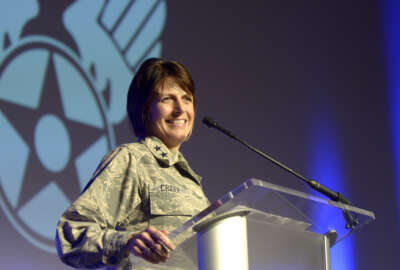
Troops maintaining bases on the moon might actually be a Space Force mission of the future
The leader of U.S. Space Command says putting troops outside the atmosphere is something that will happen in the far future.
When the Space Force was first proposed by Congress, the general population pictured sci-fi movie scenes of troops in space suits and laser guns. Now, that image may actually come true — sort of.
Maj. Gen. John Shaw confirmed Tuesday that Space Force troops will eventually be put into space, making every Arthur C. Clarke fan tingle with excitement. But also, signifying the continual escalation of space as a war domain.
Shaw is the Combined Force Space Component Command leader at U.S. Space Command.
“At some point, yes, we will be putting humans into space,” Shaw said at the AFWERX Engage Space Conference. “They may be operating a command center somewhere in the lunar environment or someplace else that we are continuing to operate architecture that is largely autonomous.”
Don’t expect to get into a shuttle anytime soon if you are in the Space Force, though.
“It’s a long ways off,” Shaw said. “For two reasons. First, space is not all that habitable for humans. We’ve learned that since our early space days. Second is we’re getting darn good at this robotics thing in space. The best robots that humans have ever created are probably satellites, either ones that explore other planets, or operated within our own Earth moon system. GPS satellites might be among those, they’re incredible machines. We’re only getting better with machine learning and artificial intelligence. We’re going to have an awful lot of automated and autonomous systems operating in earth and lunar orbit and solar orbit in the days and years to come doing national security space activity.”
For now, the Space Force is still worrying about setting itself up. It brought in more than 2,400 troops this month.
The service is setting up its organizational structure for the future.
Part of that is making the Space Force “lean and agile,” one of the requirements lawmakers made when setting up service. The point of that is to cut back on bureaucracy and keep the branch from becoming bloated with unneeded funds.
One way Chief of Space Operations Gen. Jay Raymond is doing that is by streamlining the number of offices that have their hands in space capabilities.
“If you look at missile warning architecture, there are a bunch of different organizations that have a role in that — and if you look at force design, there’s close to 30 different organizations that have a hand in that,” Raymond said. “Now that we’ve worked the organization piece of the Space Force, it’s now time to take that next step and to look upward and flatten that bureaucracy and reduce duplication.”
Another is by pushing down acquisition authority to lower levels. The Space Force’s contracting authority will not be housed in the Pentagon, but rather in field offices to be near the systems and their needs.
“I want the expert operating or developing our capabilities to be very, very close to a decision maker,” Raymond said. “I don’t want them to have to go through five or six different layers of command to get to a decision. We want to be able to do that fast.”
Right now, the service is concerned about the possible continuing resolution that may keep the service from getting all the funds it requested for 2021 on time. It requested $15.4 billion.
Raymond said a CR would slow the development of the force and possibly effect some programs like GPS III.
Copyright © 2025 Federal News Network. All rights reserved. This website is not intended for users located within the European Economic Area.
Scott Maucione is a defense reporter for Federal News Network and reports on human capital, workforce and the Defense Department at-large.
Follow @smaucioneWFED





